Key Takeaways
Discover how digital swim record boards revolutionize aquatic facility management with touchscreen technology, instant updates, and engaging multimedia displays. Complete guide to modern pool record solutions for 2025.
The Evolution from Physical to Digital Pool Record Displays
For generations, aquatic facilities have relied on physical record boards—professionally printed displays, painted gymnasium walls, or metal plaques—to document fastest times and diving scores. While these traditional approaches served their purpose, they face significant limitations that become increasingly problematic as programs grow and technology advances.
Challenges with Traditional Swim Record Boards
Physical pool record displays encounter multiple obstacles that digital technology directly addresses:
Space Limitations and Capacity Constraints: Traditional boards offer finite space, forcing difficult decisions about which records to display. As seasons progress and records fall, facilities must choose between comprehensive historical documentation and showcasing current achievements. Many programs can only display top performers in each event, leaving countless worthy achievements unrecognized.
Update Complexity and Cost: When swimmers break records, traditional boards require ordering new materials (printed inserts, engraved plates, vinyl lettering), waiting for production and shipping, scheduling installation, and often paying $100-$300+ per update. This complexity and expense sometimes results in outdated displays showing records broken months earlier, diminishing their motivational impact.
Environmental Durability Issues: Pool environments present harsh conditions with high humidity, chemical exposure from chlorine and other pool treatments, temperature fluctuations, and potential splash exposure. These factors deteriorate printed materials, fade graphics, corrode metal components, and damage adhesives over time, requiring costly maintenance and eventual replacement.
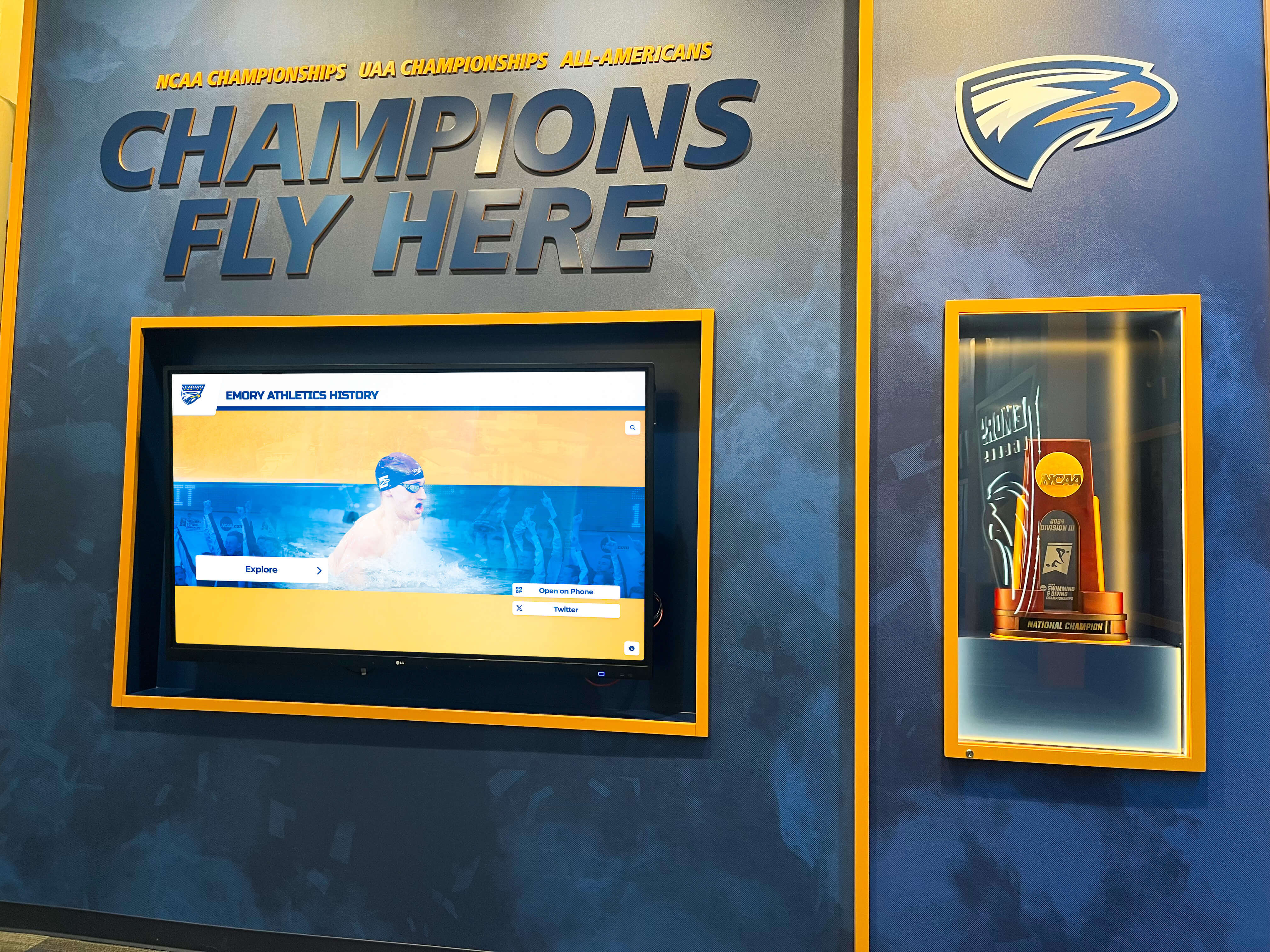
Limited Information Capacity: Physical displays typically show only basic information—swimmer name, time or score, and year—without space for context like meet details, split times, previous records, or swimmer profiles that make achievements meaningful and inspiring to current athletes.
Pool Configuration Complexity: Many programs compete in different pool lengths (25-yard, 25-meter, and 50-meter) throughout the year, each requiring separate record categories. Traditional displays struggle to accommodate this complexity without confusing layouts or multiple separate boards consuming valuable wall space.
Accessibility and Visibility Concerns: Static displays mounted at fixed locations may be difficult to view from certain areas, inaccessible to individuals with visual impairments, and completely unavailable to remote audiences including alumni, families, and community members who cannot physically visit facilities.
How Digital Technology Transforms Record Management
Digital swim record boards address every limitation of traditional displays while introducing powerful new capabilities that fundamentally improve how programs manage and celebrate aquatic achievements.
∞ Unlimited Capacity
Store complete historical records across all events, pool configurations, age groups, and eras without physical space constraints
⚡ Instant Updates
Add new records immediately from any internet-connected device without printing, shipping, or installation delays
🎬 Rich Multimedia
Include race videos, split time analysis, photo galleries, and detailed swimmer profiles bringing achievements to life
🔍 Interactive Search
Enable swimmers and spectators to search by name, event, time range, or year through intuitive touchscreen interfaces
📊 Automatic Rankings
Display dynamic top-10 all-time lists, historical progressions, and comparative analytics across eras
🌐 Remote Access
Provide online portals allowing alumni, families, and community members to explore records from anywhere
For programs seeking comprehensive record management solutions, digital record board systems provide the technological foundation for celebrating achievements while maintaining sustainable, easily updated systems that grow with programs over time.
Understanding Digital Swim Record Board Technology
Before implementing digital systems, understanding the technology components and how they work together provides essential context for making informed decisions about hardware, software, and installation approaches.
Hardware Components and Specifications
Digital swim record board systems comprise several key hardware elements:
Commercial-Grade Touchscreen Displays: Unlike consumer televisions, commercial displays are engineered for continuous operation in demanding environments. For natatorium applications, look for displays with:
- Moisture-resistant housings protecting internal components
- Anti-glare coatings maintaining visibility under bright pool lighting
- Wide viewing angles ensuring readability from various positions
- Touch-through glass rated for frequent interaction
- Commercial warranties covering extended operating hours
Screen Size Considerations: Most aquatic facilities install displays ranging from 55 to 75 inches diagonal, balancing visibility from pool deck distances with installation space availability and budget constraints. Larger facilities or those with greater viewing distances may opt for 85-inch+ displays or multiple screens.
Mounting and Protection Systems: Proper installation in pool environments requires wall-mount brackets with vibration resistance, protective enclosures providing additional moisture barriers when needed, adequate ventilation preventing condensation buildup, and positioning away from direct splash zones while maintaining optimal visibility.
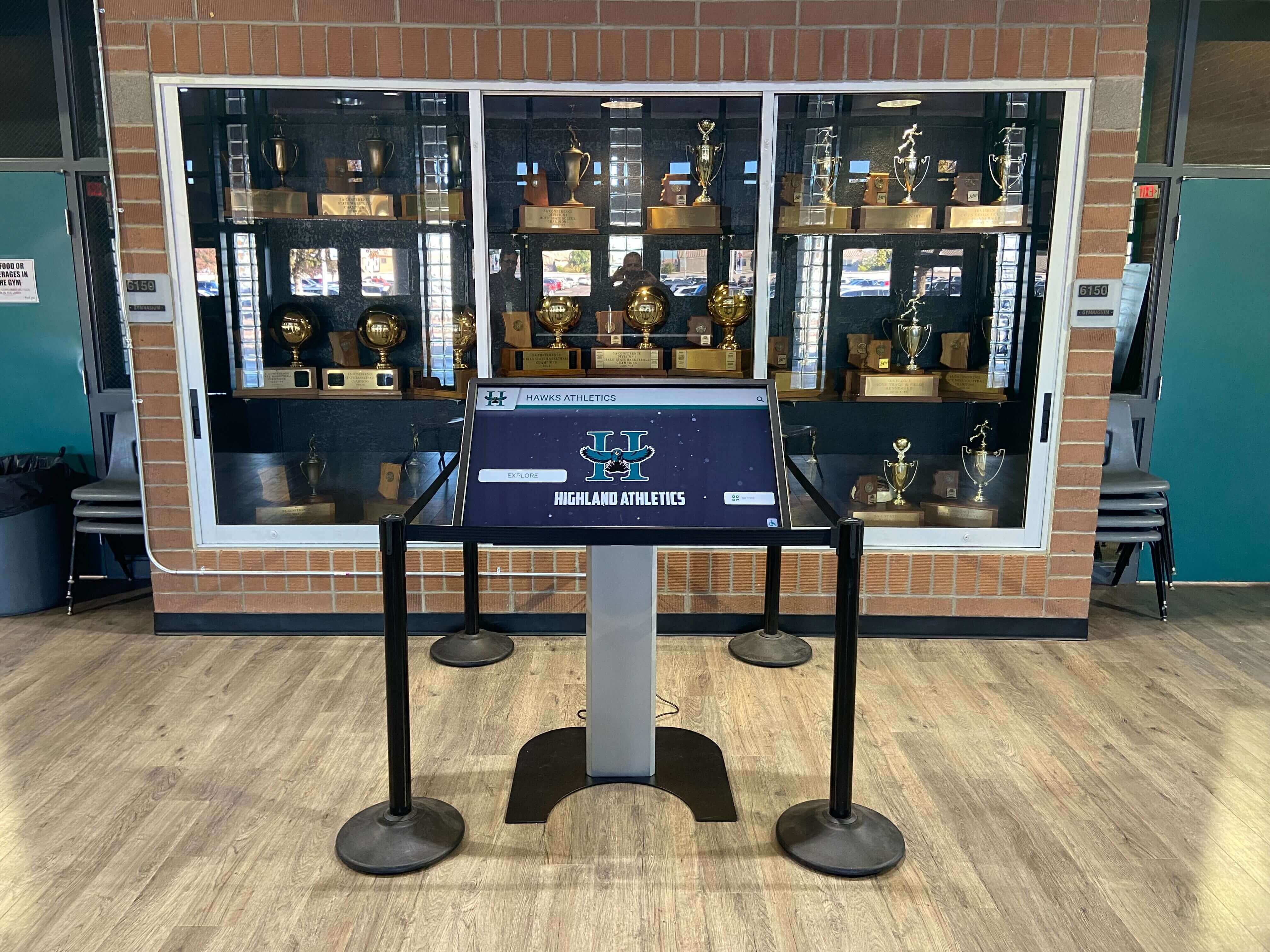
Computing and Connectivity: Digital displays require computing power to run interactive software, typically provided through embedded media players, external computer modules, or cloud-connected devices with minimal local processing. Reliable connectivity via wired ethernet (preferred for stability) or robust WiFi networks enables content updates and remote management.
Software Platforms and Content Management
The software powering digital swim record boards determines ease of use, functionality, and long-term sustainability.
Cloud-Based Management Systems: Modern platforms operate through cloud-based content management, allowing authorized users to update records, upload media, and modify layouts from any device with internet access. This approach eliminates the need for local servers, simplifies multi-user access with appropriate permissions, provides automatic backups protecting against data loss, and enables updates from coaches’ offices, homes, or even poolside during meets.
Intuitive Content Interfaces: Effective systems feature user-friendly dashboards resembling familiar social media or website builders, drag-and-drop media upload supporting photos and videos, template-based layouts ensuring consistent professional appearance, and bulk import tools for migrating historical records from spreadsheets or meet management software.
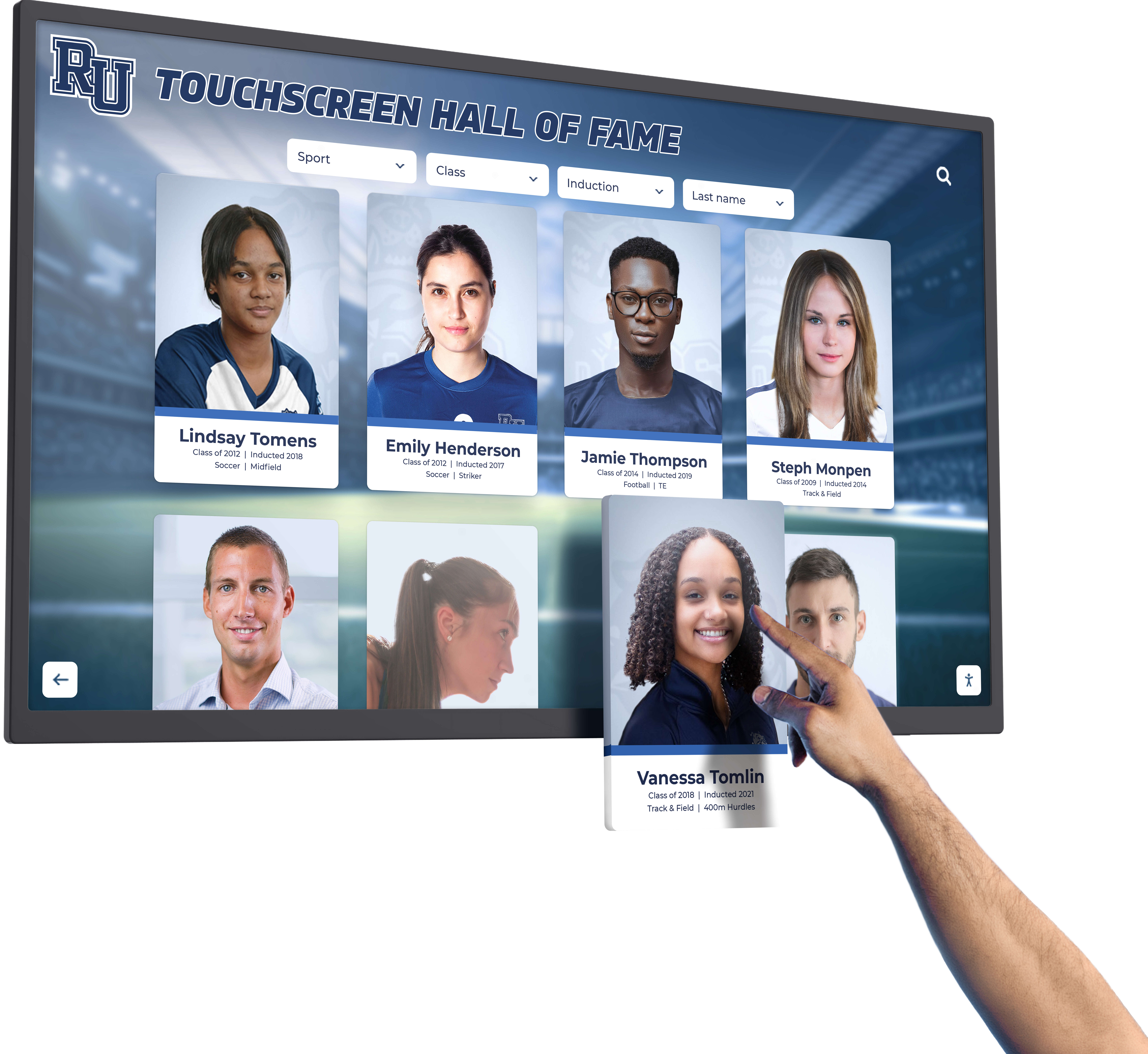
Interactive Display Features: The public-facing display that swimmers and spectators interact with should provide intuitive navigation with large touch targets requiring no instructions, powerful search functionality by swimmer name, event, or year, smart filtering enabling users to narrow results by pool configuration or time period, automatic rankings showing top-10 all-time performances, split time breakdowns for distance events, and multimedia playback of race footage and celebration photos.
For aquatic programs implementing comprehensive recognition systems, best software for education records digitization provides guidance on platforms that can integrate swim records with broader athletic achievement documentation.
Key Features of Effective Digital Swim Record Boards
The most successful digital swim record board implementations share common features that maximize engagement, simplify management, and deliver lasting value to programs.
Comprehensive Record Organization
Digital systems should accommodate the complete complexity of competitive swimming and diving:
Event-Based Organization: Separate categories for all swimming events (freestyle 50-1650 yards/meters, backstroke, breaststroke, butterfly, individual medley) and all diving events (1-meter, 3-meter springboard, platform when applicable).
Pool Configuration Management: Clear separation and easy toggling between short course yards (25Y), short course meters (25M), and long course meters (50M) records, with automatic labeling preventing confusion about which pool length applies to displayed times.
Gender and Age Group Categorization: Distinct record tracking for boys’/men’s and girls’/women’s programs, plus age group records for club programs serving multiple competitive levels (8-under, 10-under, 12-under, 14-under, etc.).
Record Type Diversity: Recognition of individual event records, relay records with all team member names and split times, season records versus career records, single-meet performances, championship meet achievements, and facility pool records versus program school/club records.
Historical Depth: Unlike physical boards limited to current record holders, digital systems can maintain complete historical progressions showing how records evolved over decades, previous record holders and how long marks stood before being broken, era-specific achievements allowing fair comparison across different competitive periods, and archived records that have since been broken but remain historically significant.
Programs can reference approaches used in synchronized swimming record boards for organizing complex aquatic achievement categories in accessible, intuitive formats.
Multimedia Integration and Storytelling
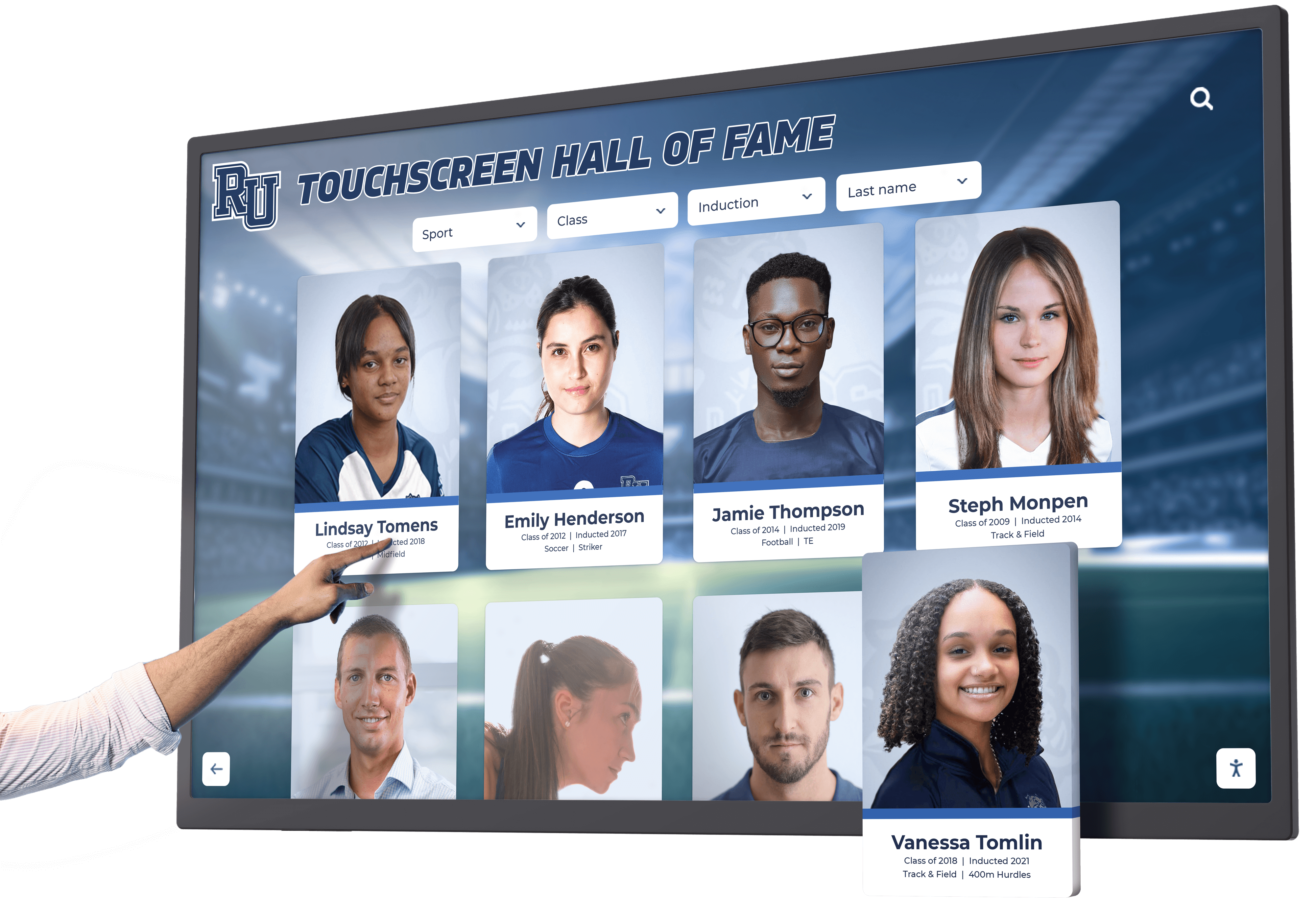
The most engaging digital record boards extend beyond basic statistics to tell complete achievement stories:
Race Video Integration: Embed video footage of record-breaking performances, championship races, or particularly memorable swims. Seeing races rather than just reading times creates emotional connections and provides technical learning opportunities for current swimmers studying form and pacing strategies.
Photo Galleries: Include action shots from races, celebration photos with coaches and teammates, awards ceremony images, and team pictures documenting the context surrounding achievements. Visual content significantly increases engagement and makes displays more compelling than text-only presentations.
Split Time Analysis: For distance events, display detailed lap-by-lap or length-by-length breakdowns showing pacing strategies and identifying where races were won or records were broken. This granular data interests serious swimmers while educating younger athletes about race strategy.
Swimmer Profiles: Provide biographical information including high school or club career highlights, college commitments and continued swimming, personal reflections on record-setting performances, and career progression showing improvement over years. These profiles transform nameless times into inspiring personal stories.
Historical Context: Explain the significance of achievements by noting the previous records and how long they stood, competitive circumstances such as championship meets versus dual meets, and era-specific context like equipment changes (tech suits) or timing system improvements (touchpads versus hand timing).
Real-Time Updates and Integration
Modern digital systems can connect with timing equipment and meet management software for seamless record updating.
Meet Management Software Integration: Many facilities use software like Hy-Tek Meet Manager, SwimTopia, or similar platforms for meet operations. Advanced digital record boards can integrate with these systems to automatically import new times after meets, identify potential new records requiring verification, and update displays without manual data entry, dramatically reducing administrative burden while ensuring records remain current.
Live Meet Display Capabilities: Some systems can display live meet results and splits during competitions, provide spectator-facing real-time updates, and automatically highlight potential record-breaking performances as they happen. This real-time functionality transforms digital displays from static historical reference into dynamic meet-day attractions.
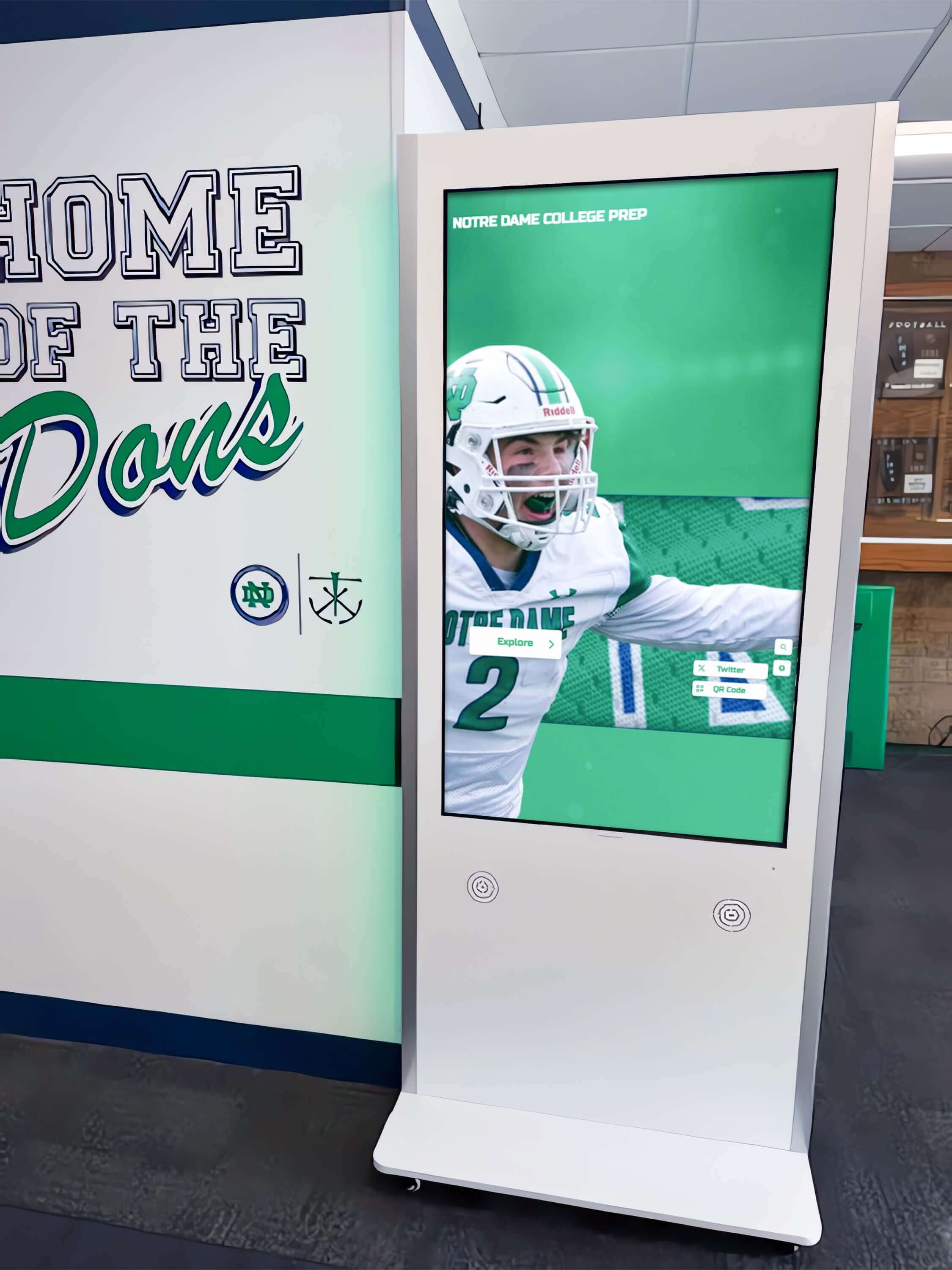
Online Portal Synchronization: Leading platforms provide companion web-based portals that automatically synchronize with physical displays, allowing remote viewing by swimmers, families, and alumni, offering mobile-responsive access from any device, and enabling easy social media sharing of specific records or achievements. This extended reach builds program visibility beyond those physically present at the pool.
Implementation Planning for Aquatic Facilities
Successful digital swim record board projects require careful planning addressing technical requirements, environmental considerations, and organizational factors unique to pool environments.
Environmental Assessment and Installation Planning
💧 Humidity Management
Assess natatorium humidity levels, ventilation systems, and condensation patterns to identify optimal installation locations and necessary protective measures
📍 Location Selection
Choose positions providing maximum visibility to swimmers and spectators while minimizing splash exposure and avoiding direct moisture sources
⚡ Power and Network
Verify electrical outlet availability and network connectivity options, planning installations that accommodate both requirements reliably
👁️ Viewing Distance
Calculate appropriate screen sizes based on primary viewing distances from pool deck, spectator areas, and lobby spaces
🛡️ Protection Measures
Determine if additional protective enclosures, enhanced ventilation, or specialized mounting is needed based on specific environmental conditions
🔧 Maintenance Access
Ensure installation allows for cleaning, service access, and potential future hardware replacement without major reconstruction
Common Installation Locations: Most facilities install digital swim record boards in pool entry lobbies where swimmers and families enter, pool deck walls visible from bleachers and competitive areas, spectator viewing areas with optimal sightlines, or athletic hallways connecting to natatorium spaces. Each location offers different advantages regarding visibility, protection from moisture, and audience engagement.
Content Migration and Data Management
Transitioning from traditional boards to digital systems requires systematic content preparation:
Historical Record Compilation: Gather existing records from current physical displays, program records books and documentation, meet results archives, and coach memory and institutional knowledge. Verify accuracy by cross-referencing multiple sources and confirming times with official meet results when available.
Data Structuring: Organize records consistently with standardized event naming conventions, consistent date formats, clear pool configuration labeling, complete swimmer name spelling, and proper attribution of relay team members. Clean, well-structured data ensures smooth system operation and prevents future confusion.
Media Asset Collection: Identify and digitize photos from historical programs and yearbooks, race videos from past competitions, swimmer biographical information, and team photos documenting different eras. Even facilities with limited historical media should document current achievements comprehensively to build rich archives going forward.
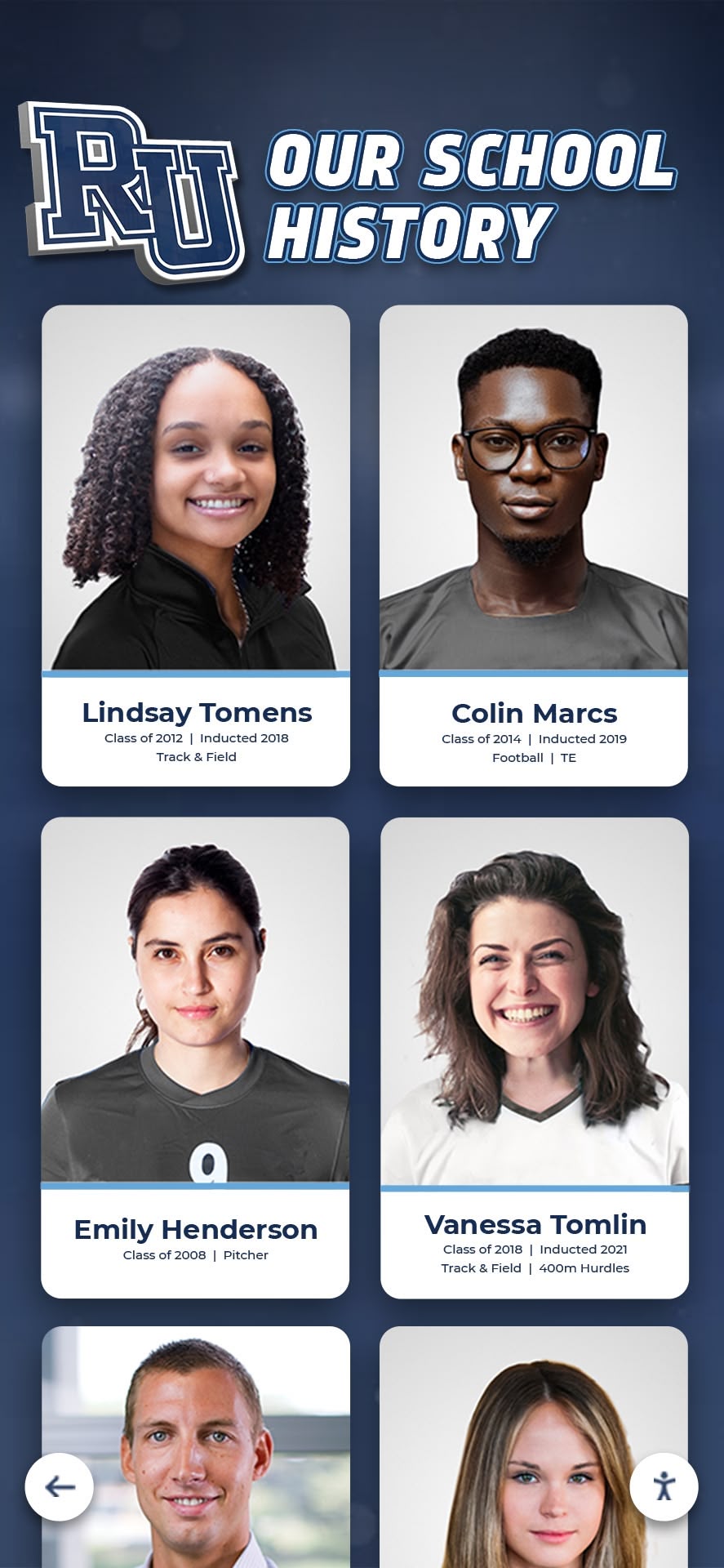
Quality Control Procedures: Before publishing records publicly, implement verification processes confirming time accuracy, checking proper name spelling and swimmer identification, ensuring correct event and pool configuration labeling, and proofreading all text content for errors. Errors on public displays undermine credibility and require corrective updates.
For programs managing diverse athletic records beyond swimming, approaches detailed in student-athlete recognition programs provide frameworks for comprehensive achievement documentation across multiple sports and recognition categories.
Maximizing Engagement and Motivational Impact
Digital swim record boards offer capabilities that traditional displays cannot match for inspiring current swimmers and engaging broader communities.
Interactive Features That Drive Engagement
Design interactive experiences that encourage exploration and repeated visits:
Powerful Search Functionality: Enable swimmers to instantly find their own performances, search for teammates’ records, locate specific years or seasons, and discover records in their primary events. Personal connection drives engagement—swimmers want to see themselves and track their progression toward record status.
Comparative Analytics: Display features showing “How Close Are You?” comparisons where swimmers input their current times to see gaps to records, historical progression graphs showing how records improved over decades, all-time rankings beyond just current record holders (top-10 or top-25 performers), and event-to-event comparisons for individual medley swimmers or multi-event athletes.
Achievement Milestones: Recognize not just records but also program-significant achievements like sub-60 second 100 freestyle performances, all qualifying standards for major meets, program-first achievements (“First swimmer to break 5:00 in 500 free”), and improvement milestones showing most improved times season-to-season.
Social Sharing Integration: Provide easy mechanisms for swimmers to share their achievements on social media, creating organic promotion while building pride. QR codes or share buttons allow instant posting of records or profiles to Instagram, Twitter, or team social channels.

Building Program Culture Through Digital Recognition
Beyond individual records, digital boards can celebrate comprehensive program achievements:
Team Record Sections: Highlight relay records with all participants, team championship wins and placing, dual meet winning streaks, and team point records at conference or state meets. These collective achievements build team identity and demonstrate that success requires contributions beyond individual stars.
Coaching Milestones: Recognize coaching tenure and achievements including wins, championships, and swimmers coached to records. Acknowledging coaches reinforces their importance to program success and honors their dedication.
Facility Records Versus Program Records: For facilities hosting multiple teams or programs, distinguish between all-time pool records set by any swimmer in the facility versus school/club team records set by your program members. This distinction provides context while maintaining focus on your program’s specific achievements.
Budget Considerations and Return on Investment
Understanding financial requirements helps programs make informed decisions about digital swim record board investments.
Investment Comparison: Traditional Versus Digital
| Cost Factor | Traditional Physical Boards | Digital Record Systems |
|---|---|---|
| Initial Installation | $3,000-$8,000 for professionally printed boards or engraved systems | $12,000-$35,000 for commercial displays, software, and installation |
| Annual Updates | $1,500-$4,000 for materials, production, and installation labor | $2,000-$5,000 for software licensing and technical support |
| Maintenance Costs | $800-$2,000 for repairs, replacements, and humidity damage | $500-$1,200 for minimal hardware maintenance and cleaning |
| 10-Year Total Cost | $26,000-$68,000 with increasing costs as materials age | $32,000-$85,000 with predictable annual costs |
| Record Capacity | Limited by physical space (typically 40-80 records maximum) | Unlimited digital capacity (thousands of records possible) |
| Update Timeline | 2-6 weeks from record to display update | Minutes from record to display update |
While digital systems require higher initial investment, they achieve cost parity within 5-7 years while delivering dramatically superior functionality, unlimited capacity, and enhanced engagement capabilities that traditional boards cannot match.
Measuring Return on Value
Beyond direct costs, digital swim record boards deliver measurable value:
Administrative Time Savings: Coaches and administrators report saving 10-20 hours annually compared to traditional board update processes, eliminating procurement, coordination, and installation scheduling, and reducing error correction and reprinting needs. This recovered time redirects to coaching, recruiting, and program development.
Enhanced Swimmer Motivation: Programs report increased swimmer engagement with records and goals, more frequent goal-setting conversations referencing specific times to beat, and heightened awareness of program history and traditions. While difficult to quantify precisely, improved motivation contributes to performance gains and program success.
Recruitment and Program Visibility: Digital displays create positive impressions during facility tours for prospective swimmers and families, demonstrate program investment in modern technology and athlete recognition, and provide shareable content for social media and program marketing. Superior recognition infrastructure supports competitive positioning against other programs.
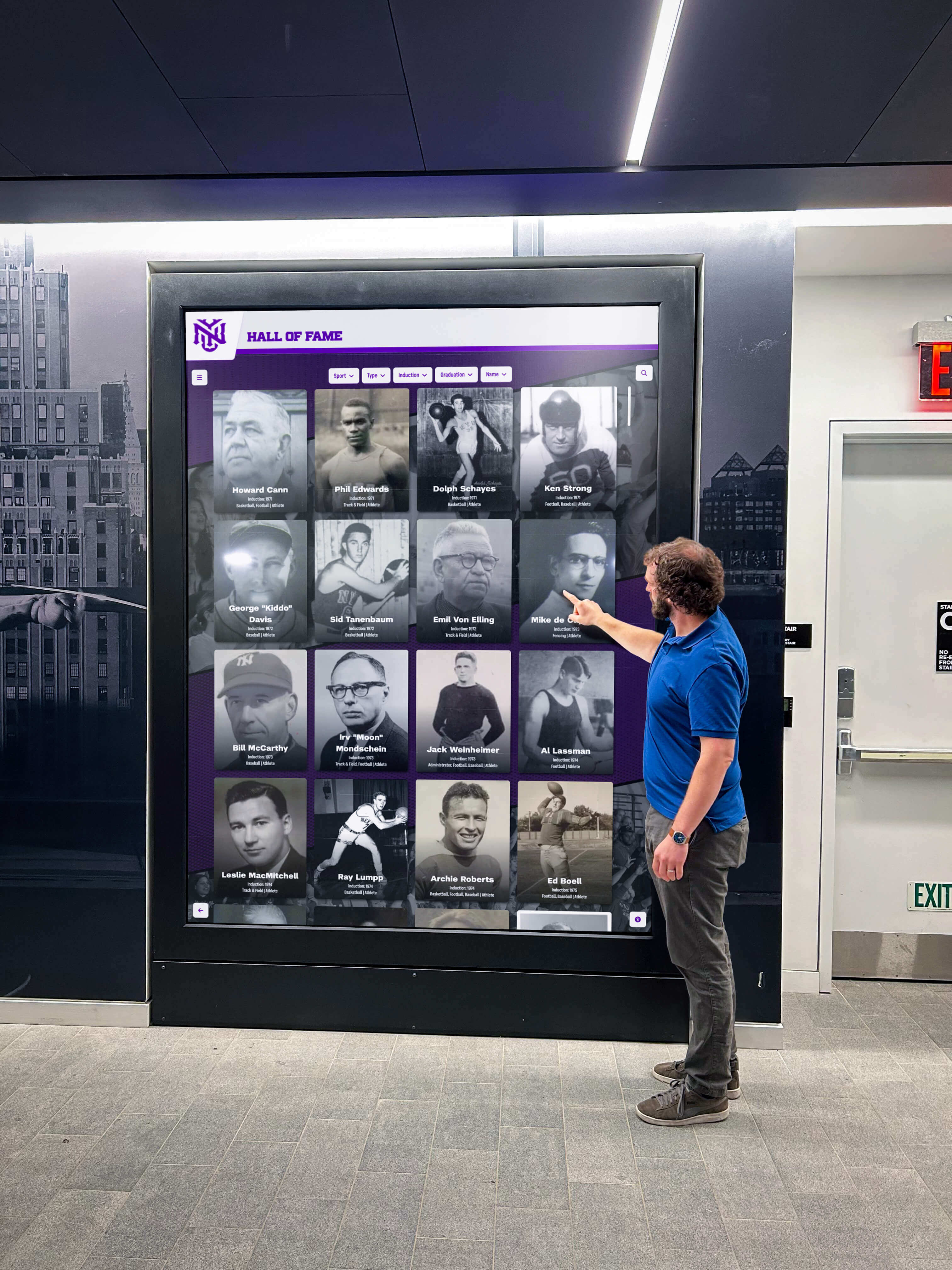
Community and Alumni Engagement: Online access extends program reach to alumni worldwide, family members unable to attend meets can view records remotely, and community members develop awareness of program excellence through accessible achievement documentation. This expanded engagement builds goodwill and potentially supports fundraising efforts.
For aquatic programs evaluating comprehensive digital infrastructure, resources on digital hall of fame planning and budgeting provide frameworks for assessing total cost of ownership and return on investment across multi-year timeframes.
Technical Considerations and Best Practices
Successful digital swim record board implementations require attention to technical details ensuring reliable long-term operation.
Environmental Protection and Durability
Pool environments demand specific technical considerations:
Moisture Management Strategies: Install displays with adequate air circulation space behind wall-mounted screens, use dehumidifiers or HVAC coordination in particularly humid areas, implement regular inspection schedules monitoring for condensation, and consider protective enclosures with active ventilation for most exposed locations.
Material Selection: Choose displays with moisture-resistant ratings appropriate for natatorium environments, stainless steel or coated hardware preventing corrosion, sealed connection points protecting electrical components, and chemically-resistant housings withstanding chlorine exposure. Proper material selection prevents premature failure.
Maintenance Protocols: Establish regular cleaning schedules using appropriate materials (microfiber cloths, approved screen cleaners), periodic inspection of mounting security and component condition, monitoring for condensation or moisture intrusion requiring intervention, and coordination with facility HVAC teams ensuring proper ventilation during all operating periods.
Expected Lifespan: When properly specified, installed, and maintained, commercial-grade digital swim record boards typically operate reliably for 7-10 years before requiring display replacement. Software and content management systems can continue operating with updated displays, protecting content investments over multiple hardware generations.
Software Selection and Vendor Evaluation
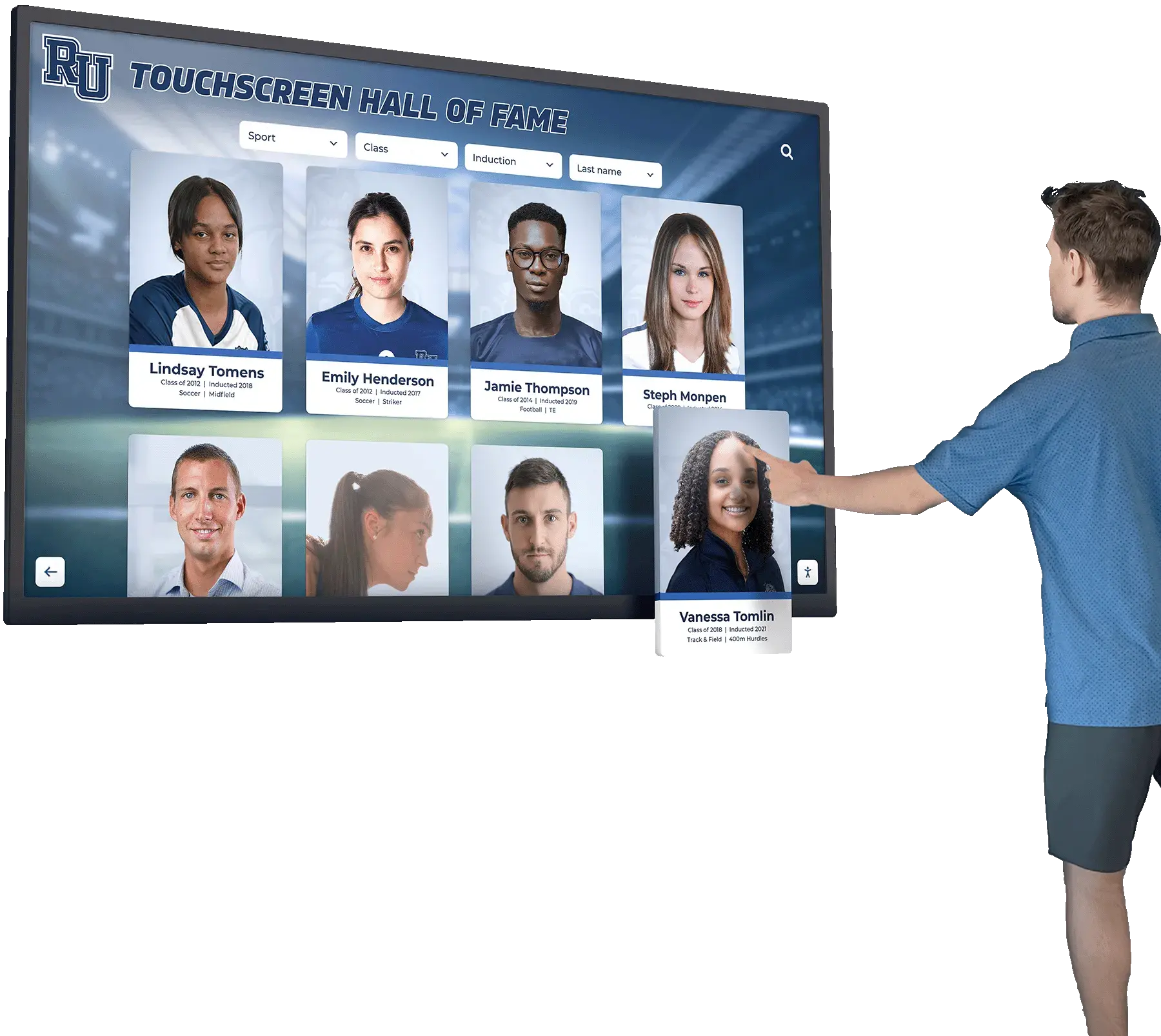
Choosing the right software platform critically impacts long-term satisfaction:
Essential Evaluation Criteria: Prioritize vendors offering proven experience with aquatic facilities specifically, intuitive content management requiring minimal training, unlimited capacity for records and media without artificial restrictions, comprehensive customer support and training programs, integration capabilities with common meet management software, mobile-responsive online portals for remote access, and strong vendor stability suggesting long-term viability.
Vendor Questions to Ask: Before committing, inquire about how many swim programs currently use their systems, specific experience with natatorium installations and environmental challenges, training and onboarding processes for new administrators, typical response times for technical support, software update frequency and whether updates include new features, data export capabilities ensuring you’re not locked into proprietary formats, and migration support if you ever need to change platforms.
Avoiding Common Pitfalls: Be cautious of consumer-grade hardware marketed as “good enough” for commercial use, generic digital signage software lacking swim-specific features, systems with restrictive capacity limits requiring upgrades as content grows, and vendors with limited customer support or unstable business prospects. The lowest initial price often proves costliest over time when systems fail or vendors disappear.
Solutions like Rocket Alumni Solutions specialize in educational and athletic recognition displays, offering platforms purpose-built for sports record management with proven reliability in demanding facility environments and comprehensive support ensuring long-term success.
Future Trends in Digital Swim Record Board Technology
The evolution of digital display technology continues creating new opportunities for aquatic programs.
Emerging Technology Integration
Forward-looking programs should watch for innovations including:
Artificial Intelligence and Analytics: AI-powered systems may soon offer predictive analytics suggesting which swimmers are on pace to break records, automatic highlight generation from race videos identifying key moments, intelligent content recommendations personalizing displays based on viewer interests, and natural language search allowing voice-activated record queries.
Augmented Reality Features: AR capabilities could enable mobile device overlay showing 3D race reconstructions, virtual trophy displays appearing in physical spaces through smartphone screens, comparative race visualization showing current swimmers racing against record holders, and immersive historical experiences bringing past achievements to life.
Biometric Integration: Future systems might connect with wearable technology tracking training metrics, display correlations between training data and competition results, provide personalized performance analytics to swimmers, and offer injury prevention insights based on workload monitoring.
Social Media and Content Automation: Advanced platforms will likely feature automatic social media posting when records fall, AI-generated highlight videos for sharing, parent notification systems alerting families to achievements, and community content contributions allowing alumni to submit historical photos and stories.
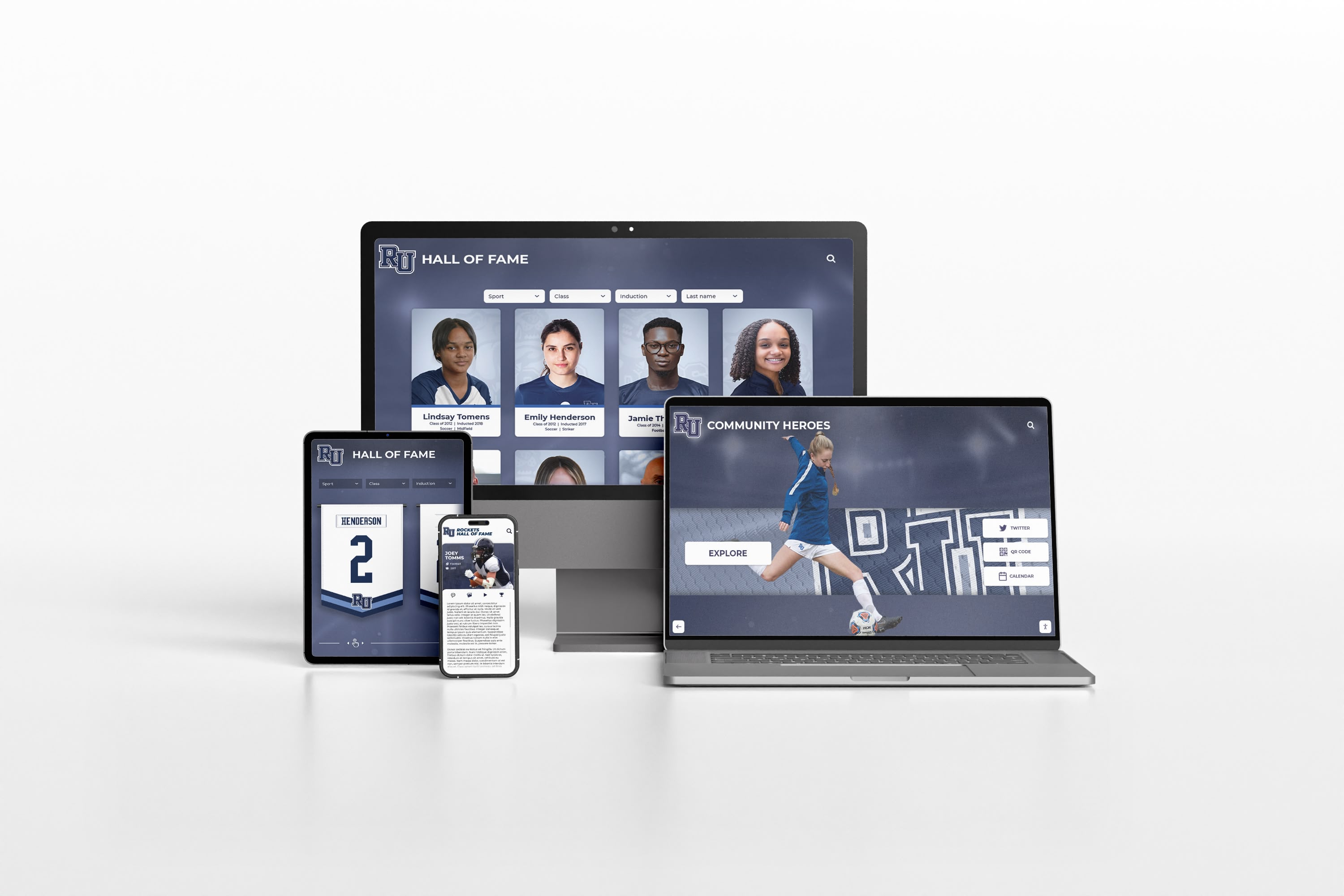
Sustainability and Environmental Considerations
Digital systems align with institutional sustainability goals through elimination of printed materials and ongoing paper/vinyl waste, reduced shipping and transportation for physical updates, energy-efficient LED display technology consuming less power than older screens, and long-term utility of content investments surviving multiple hardware generations. Programs increasingly view digital record boards as environmentally responsible choices compared to continuously producing and discarding physical materials.
Conclusion: Transforming Pool Record Management
Digital swim record boards represent significant evolution from traditional physical displays, addressing every limitation while introducing powerful capabilities that fundamentally transform how aquatic programs manage and celebrate achievements. Through unlimited capacity eliminating space constraints, instant updates requiring no physical materials, rich multimedia integration bringing performances to life, interactive exploration engaging swimmers and spectators, and remote accessibility extending reach beyond facility walls, these modern systems create recognition experiences impossible with static traditional boards.
While initial investment exceeds traditional physical displays, digital systems achieve cost parity within 5-7 years while delivering dramatically superior functionality, simplified management, and enhanced engagement. More importantly, they transform record boards from static historical reference into dynamic motivational tools that inspire current swimmers, engage families and communities, and position programs as forward-thinking organizations investing in modern athlete recognition.
The pool environment presents unique challenges requiring proper hardware selection, thoughtful installation planning, and appropriate environmental protection. However, thousands of facilities have successfully implemented digital record boards in natatoriums, demonstrating that with proper specification and installation, these systems reliably operate in humid aquatic conditions.
For swim programs ready to modernize record management while creating more engaging recognition experiences, digital swim record board solutions from providers like Rocket Alumni Solutions offer comprehensive platforms specifically designed for aquatic facilities, combining purpose-built technology with proven reliability and comprehensive support ensuring long-term success.






































